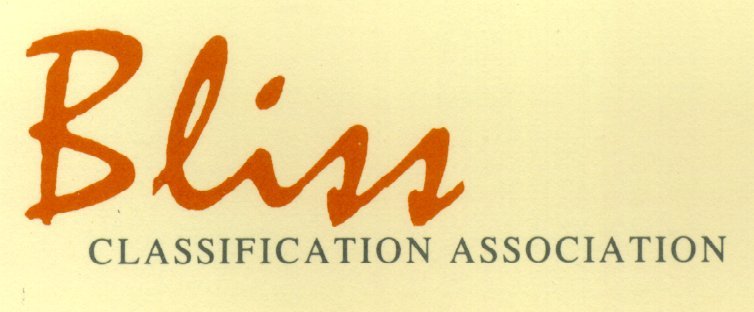
The classification (BC2):
History and description | Using the scheme | Schedules | Library users | Bibliography
The association (BCA):
Annual lectures | BC
Bulletin | BCA Organization |
Join the BCA | Contacts
The standard categories recognised in ‘classical’ facet analysis are:
Thing – kind – part – property – material – process – operation – patient – product – by-product – agent – space – time
Any item, document or object acquired is placed into a subject arrangement (classification) by examining which categories are represented, then using the notation for these categories to build a classmark representing them in a fixed and easily remembered order.
EXAMPLE: an item on residential care for the elderly is placed first in the 'Patient' category and then in a 'Operation' sub-category. In the Social Welfare class (Q), the classmark representing this compound class is QLV EL:
Q Social welfare QEL Residential care QLV Old people
Adding more detail is straightforward. For example, library provision for the elderly in residential care combines:
Q Social welfare QEL Residential care QEP X Library provision QLV Old people
The classmark QLV EPX L represents the subject exactly.
For example, classmarks can be derived as follows:
Questionnaires on changes in marriage patterns among Muslims in France: KVF QSP BKC E7N
K Society K7N Questionnaires KCE Social change KPB K Muslims KQS Marriage KVF France
Unemployment in rural communities in India: KVQ EOM MUR
KMU R Rural communities KOM Unemployed persons KVQ E Indian society
Field studies of kinship in hunter-gatherer societies: KSX JPG 9V
K9V Field studies KPG Kinship KSX J Hunter-gatherer societies
Community care policy: QEN AGP
Q Social welfare QAG P Policy QEN Community care
Working with parents and pre-school children: QLP KPB CP
QBC P Partnership QE Social services QKP Parents QLP Pre-school children
It is also possible to use other devices for building classmarks which are even more specific, such as alphabetical devices to represent the name of an individual or an organisation. Detailed instructions are given in the Introduction to each class and within each schedule.
To specify place, date, language or form the Common Auxiliary Schedules (from the BC2 volume Introduction and Auxiliary Schedules) are used:
European child protection services. Training pack for carers: QLJ JE8 D2F P
QLJ JE Child protection services 8D Europe 2FP Multimedia
Handbook of personnel management
TU Personnel management 3MK Guides, handbooks
The order in which the facets are built up (i.e. from special to general) is called the citation order and BC2 is designed to give the most logical and helpful order, whether browsing books on the shelf or organising web resources. In Class K (Society), for example, all works on aspects of French society will be gathered together at KVF and on Indian society at KVQ E, whereas material on Muslim societies in general will be at KPB K and unemployed people in general at KOM.
A library specialising in Sociology or Social Anthropology may wish to keep all 'fringe' subjects, e.g. Psychology (Class I), Religion (Class P), Politics (Class R), within Class K, rather than create separate sections. BC2 provides for this by drawing material from its other schedules into Class K. Classifiers may need to refer to these other schedules for detailed vocabulary.
The classifier’s first task must be to decide on which alternatives are best for the library's users and to mark these in the schedule. Once chosen, the alternatives must be adhered to.
Kinship: hunter-gatherer societies KSX JPG Muslims: marriage: French society KVF QSP BK Rural communities: unemployment: Indian society KVQ EOM MUR